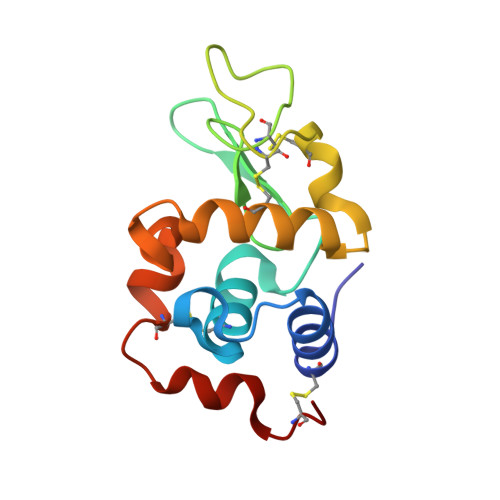A few low-frequency normal modes predominantly contribute to conformational responses of hen egg white lysozyme in the tetragonal crystal to variations of molecular packing controlled by environmental humidity
Takayama, Y., Nakasako, M.(2011) Biophys Chem 159: 237-246
- PubMed: 21802827
- DOI: https://doi.org/10.1016/j.bpc.2011.07.001
- Primary Citation of Related Structures:
3AW6, 3AW7 - PubMed Abstract:
The structures of proteins in crystals are fixed by molecular interactions with neighboring molecules, except in non-contacting flexible regions. Thus, it is difficult to imagine what conformational changes occur in solution. However, if molecular interactions can be changed by manipulating molecular packing in crystals, it may be possible to visualize conformational responses of proteins at atomic resolution by diffraction experiments. For this purpose, it is suitable to control the molecular packing in protein crystals by changing the volume of solvent channels through variation of the environmental relative humidity. Here, we studied conformational responses of hen egg white lysozyme (HEWL) in the tetragonal crystal by X-ray diffraction experiments using a humidity-control apparatus, which provided air flow of 20-98%rh at 298 K. First, we monitored the lattice parameters and crystalline order during dehydration and rehydration of HEWL crystal between 61 and 94%rh at 300 K. Then two crystal structures at a resolution of 2.1 Å using diffraction data obtained at 84.2 and 71.9%rh were determined to discuss the conformational responses of HEWL against the external perturbation induced by changes in molecular packing. The structure at 71.9%rh displayed a closure movement that was likely induced by the molecular contacts formed during dehydration and could be approximated by ten low-frequency normal modes for the crystal structure obtained at 84.2%rh. In addition, we observed reorganization of hydration structures at the molecular interfaces between symmetry neighbors. These findings suggest that humidity-controlled X-ray crystallography is an effective tool to investigate the responses of inherent intramolecular motions of proteins to external perturbations.
- Department of Physics, Faculty of Science and Technology, Keio University, 3-14-1 Hiyoshi, Kanagawa 223-8522, Japan.
Organizational Affiliation:



















